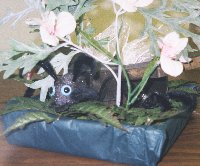I've Got that Geometry Bug!
I’ve got that Geometry Bug!
 Hexus
is the name of my geometry bug. He is a very rare beetle that lives in the
Amazon River Basin in South America. He is a tropical bug that is almost
iridescent in appearance. This makes him hard to see by predators and also by
his prey. Hexus eats other small pesky insects that cause damage to the trees
and plant material in the forest. He flies and crawls to get himself around in
his huge environment.
Hexus
is the name of my geometry bug. He is a very rare beetle that lives in the
Amazon River Basin in South America. He is a tropical bug that is almost
iridescent in appearance. This makes him hard to see by predators and also by
his prey. Hexus eats other small pesky insects that cause damage to the trees
and plant material in the forest. He flies and crawls to get himself around in
his huge environment.
Hexus’ body is made from two
hexagons. The larger one is the abdomen and the smaller one is the thorax. His
head is an oval shape. He has bright blue eyes and mandibles for chewing. Hexus
has three pairs of legs that are attached to the thorax. He has antennae or
feelers on his head. Spiracles are located on each side of his abdomen and are
used for breathing. Insects’ skeletons are actually on the outside of the body,
protecting the soft muscles and tissues that make up the body. Hexus has two
sets of wings that are hidden by this outer shell. Since Hexus is a large
beetle, he does not fly far, but uses his strong legs to crawl up and down the
trunks of trees.
 The
legs of an insect are triple jointed and consist of the tarsus, the tibia, and
the femur. Hexus has thick strong legs to help him hold onto branches. The
segments of the leg are actually line segments and the joints are vertices.
Angles are part of any three-dimensional figure. There are straight, right,
acute, and obtuse angles. The insect body is also made out of polygons or plane
figures. The body of an insect is symmetrical. It looks the same on each half
of the bug. Other geometrical features of an insect are perpendicular lines,
parallel lines, arcs, and semi-circles. The wings form vertical angles and are
sometimes called butterfly angles.
The
legs of an insect are triple jointed and consist of the tarsus, the tibia, and
the femur. Hexus has thick strong legs to help him hold onto branches. The
segments of the leg are actually line segments and the joints are vertices.
Angles are part of any three-dimensional figure. There are straight, right,
acute, and obtuse angles. The insect body is also made out of polygons or plane
figures. The body of an insect is symmetrical. It looks the same on each half
of the bug. Other geometrical features of an insect are perpendicular lines,
parallel lines, arcs, and semi-circles. The wings form vertical angles and are
sometimes called butterfly angles.
The purpose of the hexagon is to
provide a strong structure, support. The mandibles are semi-circular for
grabbing and holding prey. The wings are angles for aerodynamics.
Like
humans, all insects are very different. They are different colors, shapes and
sizes. All are unique and special. My geometrical creation is probably the most
unique.
Bibliography:
- Borror, Donald J., Dwight M. De Long, Charles A.
Triplehorn. An Introduction to the Study of Insects fifth edition.
Philadelphia: Saunders College Publishing, copyright 1981.
- Calahan, Philip. Insects and how they function.
New York: Holiday House, copyright 1971.
- Hobbs, Jack. Art in Context. New York: Harcourt
Brace Jovanovich, Inc., copyright 1975.
- Krieger, Larry S., Dr. Edward Reynolds, Kenneth Neil. World
History: Perspectives on the Past fifth edition. Evanston, Illinois:
Houghton Mifflin Company, copyright 1997.
- World Book Encyclopedia 1998, volume 10, pages 278-301. Chicago:
Scott Fetzer Company, copyright 1998.
Project
Description
Research Questions
Student Work
|